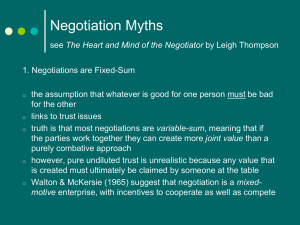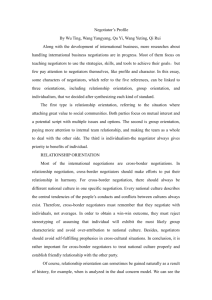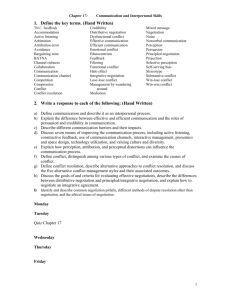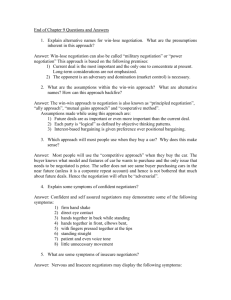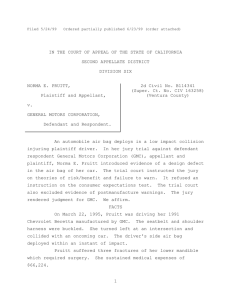Summer 2006: Trust - Asherman Associates
advertisement
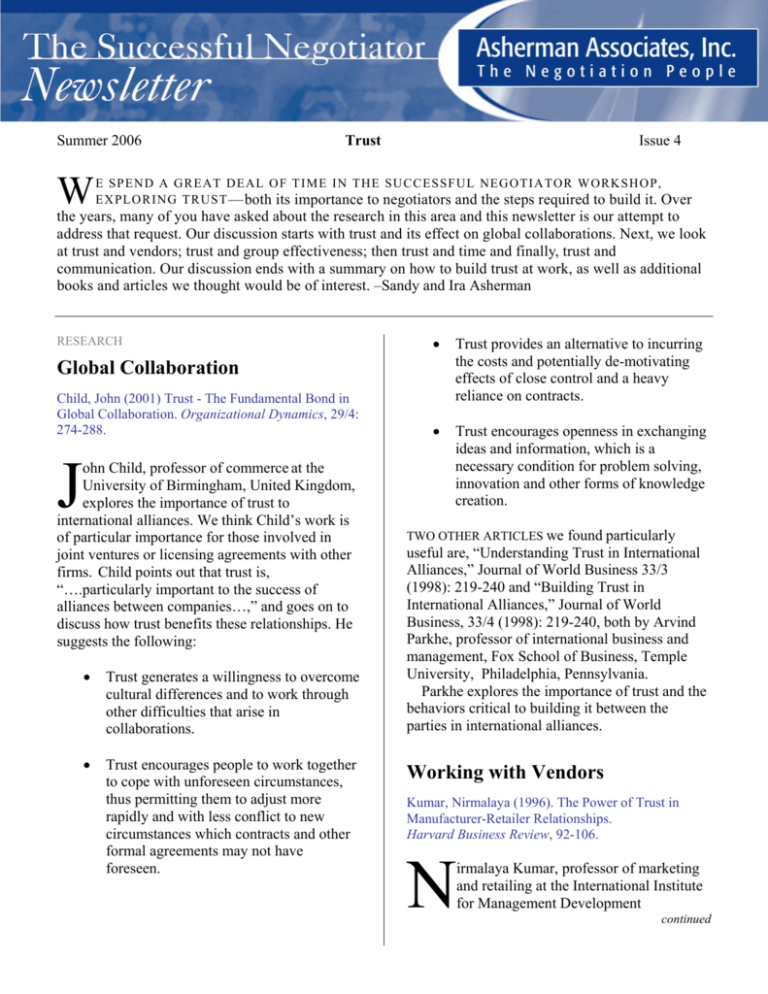
Summer 2006 W Issue 4 Trust E SPEND A G REAT D EAL OF TI ME IN THE SU CCESSFUL NEGO TIATOR W ORKSHO P, EX PLO RING TRUST —both its importance to negotiators and the steps required to build it. Over the years, many of you have asked about the research in this area and this newsletter is our attempt to address that request. Our discussion starts with trust and its effect on global collaborations. Next, we look at trust and vendors; trust and group effectiveness; then trust and time and finally, trust and communication. Our discussion ends with a summary on how to build trust at work, as well as additional books and articles we thought would be of interest. –Sandy and Ira Asherman RESEARCH • Trust provides an alternative to incurring the costs and potentially de-motivating effects of close control and a heavy reliance on contracts. • Trust encourages openness in exchanging ideas and information, which is a necessary condition for problem solving, innovation and other forms of knowledge creation. Global Collaboration Child, John (2001) Trust - The Fundamental Bond in Global Collaboration. Organizational Dynamics, 29/4: 274-288. J ohn Child, professor of commerce at the University of Birmingham, United Kingdom, explores the importance of trust to international alliances. We think Child’s work is of particular importance for those involved in joint ventures or licensing agreements with other firms. Child points out that trust is, “….particularly important to the success of alliances between companies…,” and goes on to discuss how trust benefits these relationships. He suggests the following: • Trust generates a willingness to overcome cultural differences and to work through other difficulties that arise in collaborations. • Trust encourages people to work together to cope with unforeseen circumstances, thus permitting them to adjust more rapidly and with less conflict to new circumstances which contracts and other formal agreements may not have foreseen. TWO OTHER ARTICLES we found particularly useful are, “Understanding Trust in International Alliances,” Journal of World Business 33/3 (1998): 219-240 and “Building Trust in International Alliances,” Journal of World Business, 33/4 (1998): 219-240, both by Arvind Parkhe, professor of international business and management, Fox School of Business, Temple University, Philadelphia, Pennsylvania. Parkhe explores the importance of trust and the behaviors critical to building it between the parties in international alliances. Working with Vendors Kumar, Nirmalaya (1996). The Power of Trust in Manufacturer-Retailer Relationships. Harvard Business Review, 92-106. N irmalaya Kumar, professor of marketing and retailing at the International Institute for Management Development continued Working With Vendors (continued) in Lausanne, Switzerland, finds that trust between manufacturers and retailers is good for sales. “Retailers with a high level of trust in the manufacturer generated 78% more sales than those with a low level,” writes Kumar, whose study focuses primarily on companies in England. His work is instructive when thinking about relationships with CROs and other major suppliers and vendors. According to Numar: • • • • [Trust] creates a reservoir of goodwill that helps preserve the relationship when, as will inevitably happen, one party engages in an act that its partner considers destructive. Trust helps manufacturer-retailer relationships realize their full potential. When both sides trust each other, they are able to share confidential information, invest in understanding the other’s business, customize their information systems or dedicate people and resources to serve each other better. A trusting party typically will not feel it needs to monitor its counterpart’s behavior, thereby cutting its monitoring costs. Trust allows a company to capture the hearts and minds of partners so that they will go the extra mile. Schurr, Paul H. & Ozanne, Julie L. (1985). Influences on the Exchange Processes: Buyers’ Preconceptions of a Seller’s Trustworthiness and Bargaining Toughness. Journal of Consumer Research: An Interdisciplinary Quarterly, University of Chicago Press, 11/4, 939-53. Their study reported the following: • High trust beliefs, compared with low trust beliefs, cause a high level of agreement, a more favorable attitude toward the vendor, and fewer rejections of the vendor as too tough. • When a buyer believes a seller will adopt a tough bargaining stance and at the same time believes the seller to be untrustworthy, the buyer/seller interaction is least favorable to the seller in terms of total concessions and level of agreement reached. • Expecting the seller to be trustworthy and to engage in tough bargaining, causes the buyer to be more integrative toward the seller in terms of message sending and concession making behavior. • In a low trust situation, the buyer may request self-disclosure of concession priorities, but not reciprocate with his/her own self-disclosure. continued │2 Trust and Group Effectiveness Zand, Dale. (1972).Trust and Managerial Problem Solving. Administrative Science Quarterly, 17/2: 229239. I N this study, which is included in our book, The Negotiation Sourcebook, Dale E. Zand, former professor of management at the New York University, Stern School of Business, explores the impact of trust on group problem solving. We think this study is crucial for project teams who must negotiate with each other over the wide range of issues teams face. Zand argues that: • High trust stimulates the exchange of self-disclosures, as well as constructive dialogue and problem solving effectiveness. • • • High levels of trust are associated with better goal clarification between parties, greater exchange of information, greater problem solving and greater commitment to agreements. In low-trust groups, interpersonal relationships interfere with and distort perceptions of the problem. Energy and creativity are directed from finding comprehensive, realistic solutions, and members use the problem as an instrument to minimize their vulnerability. In the high-trust groups, there is less socially generated uncertainty and problems are solved more effectively. There are significant differences in effectiveness between the high-trust groups and low-trust groups in the clarification of goals, the reality of Why Dream Teams Fail, Fortune Magazine, 153, 87-92 Colvin, Geoffrey (2006) Writing in the June 12, 2006 issue of Fortune Magazine, Geoffrey Colvin describes how trust can affect a team: “. . . it always comes down to this: Trust is the most fundamental element of a winning team. If people think their teammates are lying, withholding information, plotting to knife them . . . nothing valuable will be done. This special issue on teamwork is the second in a series called the Secrets of Greatness. information exchange, the scope of the search for solutions and the commitment of managers to implement solutions. (Zand is also author of The Leadership Triad, Oxford University Press, 1997.) Boss, R.W. (1978) Trust and Managerial Problem Solving Revisited. Group and Organizational Studies, 3(3), 331-342. Dr. R. Wayne Boss, professor at Leeds School of Business, University of Colorado at Boulder, repeating Zand’s experiment on trust and group effectiveness several years later, reported nearly identical results. “Under conditions of high trust, problem solving tends to be creative and productive,” and “Under conditions of low trust, problem solving tends to be degenerative and ineffective.” continued │3 Trust and Group Effectiveness (continued) Dirks, Kurt T. (1999) the Effects of Interpersonal Trust on Work Group Performance. Journal of Applied Psychology, 84, 445-455. Kurt T. Dirks is associate professor of organizational behavior, Olin School of Business, Washington University in St. Louis. This study has its greatest application for temporary work groups and task forces. Dirks’ key findings follow: • • In high-trust groups, motivation is transformed into joint efforts and hence, higher performance; In low-trust groups, motivation is transformed into individual efforts. Trust and Communication Kimmel, M, Pruitt, D., Magenau, J., Konar-Goldband, E., & Carnevale, P. (1980), Effects of Trust, Aspiration, and Gender on Negotiation Tactics. Journal of Personality and Social Psychology, 38/1: 922. These authors found that high trust fosters cooperative behavior, especially in the form of self-disclosure about needs and priorities. Specifically: • Negotiators regard statements about their needs and priorities as risky in bargaining settings and hence are only willing to make them if they trust one another. • A problem-solving orientation naturally makes negotiators partial to a problem solving discussion. But the more obvious forms of such a discussion, involving frank statements about one’s needs and • Priorities are only possible where trust exists. • As might be expected, they found that low trust produces less cooperative behavior Time Pressure Carnevale, P.J.D. & Lawler, Edward J. (1986), Time Pressure and the Development of Integrative Agreements in Bilateral Negotiations. Journal of Conflict Resolution, 30, 636-659. We believe there needs to be a high degree of trust to operate effectively under time pressure, which is why we’ve included this study in our discussion. These researchers don’t talk about trust directly but suggest that cooperation, a behavior that thrives in high-trust relationships makes it easier and faster for parties to reach an agreement: • For negotiators with a cooperative orientation, time pressure has no effect on the ease of reaching agreement or on the quality of the agreement. • For negotiators with an individualistic orientation, high time pressure results in a greater inability to reach agreement and when agreement is reached, poor negotiation outcomes. Time pressure inhibits the process of conflict resolution when negotiators adopt an individualistic orientation, but not when they adopt a cooperative orientation. continued │4 Trust Building Behaviors Conclusion Bohnet, Iris. (2004). The Payoff of Trust. Negotiation, Harvard Business School Publishing. In her article on trust betrayal, Iris Bohnet urges us to overcome our fears by laying out the benefits of high trust working relationships. She points out that: The lubricant of society, trust allows us to interact, engage, and trade with one another even in the absence of formal contract enforcement. Trust helps us prevent and resolve conflicts. Trust also helps us negotiate in good faith, exchanging information and trading on differences to reach integrative deals that make everyone better off. She would like negotiators to take the chance to trust others. Why? “People who believe their counterparts trust them, are more likely to respond in a trustworthy manner,” she writes. In other words—and this is a point we want to underscore—when we trust others, others are likely to trust us—trust begets trust—and conversely, when we are aggressive and confrontational, we can expect others to treat us in the same way. “Only by being vulnerable to betrayal and assuming the inherent risk of any exchange can we generate high levels of trust and trustworthiness,” she writes. In summary, it is safe to say that high trust brings extensive and valuable benefits to the work we do. It not only speeds up the process, but also ensures that all information is shared and better solutions achieved. We hope that you will find the above information helpful. Please let us know if you have any comments or questions. Trust is not something that happens by chance– there are a number of behaviors that help to reinforce and build high trust working relationships. Paul Bernthal, in A Survey of Trust in the Workplace, 1995 Pittsburgh, PA: DDI Center for Applied Behavioral Research looked at trust and team leadership and the behaviors critical to building and reducing trust and found the following: Behaviors that engender trust in a leader: • Communicates openly and honestly, without distorting information. • Shows confidence in workers’ abilities. • Listens and values what the workers say, even though he/she may not agree. • Keeps promises and commitments. • Makes sure her/his reactions are consistent with his/her words and practices. Behaviors that reduce trust in a leader: • Sends mixed messages. • Acts more concerned with his /her welfare than anything else. • Avoids taking responsibility, lies or hides information. continued │5 List of References Trust Building Behaviors In our own work, we have also identified a number of behaviors critical to building trust. They are: • Following through on your commitments. • Letting people know when commitments cannot be met. • Being consistent in your words and actions. High trust people consistently do what they say and are consistent over time. • Sharing information. High trust people do not withhold information or use it to exercise power. • Taking time with people • Admitting when you make a mistake or don’t know something • Accepting responsibility when things go wrong. Don’t blame others. Books Huemar, Lars. (1998). Trust in Business Relations: Economic Logic or Social Interaction? Sweden: Boréa Bokförlag. Reina, Dennis S. & Reina, Michelle L. (1999). Trust and Betrayal in the Workplace. San Francisco: Berrett-Koehler Publishers. Roderick Moreland Kramer. (1995, November). Trust in Organizations. Sage Publications. Pruitt, D. G., & Carnevale, P. J. (1982). The Development of Integrative Agreements in Social Conflict. In V. J. Derlega and J. Grzelak (Eds.), Living with Other People. New York: Academic Press. Pruitt, D. G. (1981). Negotiation Behavior. New York: Academic Press. Sako, M. (1992) Prices, Quality, Trust: Inter-firm Relations in Britain and Japan. Cambridge: Cambridge University Press. Articles Doney, Patricia M. (1998, July). Understanding the Influence of National Culture on the Development of Trust. Academy of Management Review, 23. Driscoll, J.W. (1973). Trust and Participation in Organizational Decision Making As Predictors of Satisfaction. Academy of Management Journal, 21, 44. Friedlander, F. (1970). The Primacy of Trust as a Facilitator of Group Accomplishment. Journal of Applied Behavioral Science, 6, 387-400. Recent Articles Ira’s most recent article, “Getting the Most Out of Negotiation Training,” is available on our website, www.asherman.com, where you can download a free copy. While you’re at the site, be sure to check out: • “Language, Culture and the Drug Development Process,” June and October 2005, DIA Forum, and • “Management Training in the MultiCultural Work Force,” December 2004, The Regulatory Affairs Focus Galford, R., Drapeau, A.S. (2003, Feb). The Enemies of Trust, Harvard Business Review. Hosmer, L.T. (1995). Trust: The Connecting Link Between Organizational Theory and Philosophical Ethics. Academy of Management Review, 20, 379-403. Jeffries, Frank L. (2000, October). Trust and Adaptation in Relational Contracting. Academy of Management Review. Kramer, Roderick M. (1999, February). Trust and Distrust in Organizations: Emerging Perspectives, Enduring Questions. Annual Review of Psychology, 50, 569-598. Morgan, R.M., Hunt, S.D. (1994, July). The Commitment-Trust Theory of Relationship Marketing. Journal of Marketing, 58, 20-38. Organizational Studies. (2001, March). Trust and Control in Organizational Relations. This special issue is devoted to trust and organizations. Six papers are presented. continued │6 Pruitt, D. G., Carnevale, P. J. D., Forcey, B., & Van Slyck, M. (1986). Gender Effects in Negotiation: Constituent Surveillance and Contentious Behavior. Journal of Experimental Social Psychology, 22, 264-275. NOTES: Pruitt, D. G. & Syna, H. (1985). Mismatching the Opponent’s Offers in Negotiations. Journal of Experimental Social Psychology, 21, 103-113. Pruitt, D. G., Carnevale, P. J., Ben-Yoav, O., Nochajski, T. H., & Van Slyk, M. R. (1983). Incentives for Cooperation in Integrative Bargaining. In R. Teitz (Ed.), Aspiration Levels in Bargaining and Economic Decision Making, 213, 22-34. Berlin: Springer-Verlag. Pruitt, D. G., & Lewis, S. (1975). Development of Integrative Solutions in Bilateral Negotiation. Journal of Personality and Social Psychology, 31, 621-633. Sinetar, M. (1988). Building Trust into Corporate Relationships. Organizational Dynamics, 16, 73-79. Schoorman, F.D., Mayer, R.C., & Davis, J.H. (1996). Organizational Trust: Philosophical Perspectives and Conceptual Definitions. Academy of Management Journal, 38, 24-59. Taylor, R.G., Jr. (1990, fall). Trust and Influence in the Workplace. Organizational Development Journal, 33-36. Friedlander, F. (1970). The Primacy of Trust as a Facilitator of Group Accomplishment. Journal of Applied Behavioral Science, 6, 387-400. Galford, R., Drapeau, A.S. (2003, Feb). The Enemies of Trust, Harvard Business Review. Sinetar, M. (1988). Building Trust into Corporate Relationships. Organizational Dynamics, 16, 73-79. Schoorman, F.D., Mayer, R.C., & Davis, J.H. (1996). Organizational Trust: Philosophical Perspectives and Conceptual Definitions. Academy of Management Journal, 38, 24-59. Website: www.asherman.com E-mail: sandy@asherman.com, ira@asherman.com 210 W. 19th Street, New York, NY 10011 Tel. 212-243-0782 Fax 212-243-1375 Distributed by Elite Communication Graphics © Copyright Asherman Associates, Inc. 2006 │7
